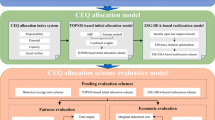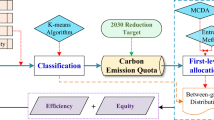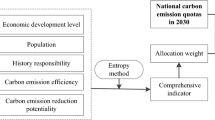Abstract
Carbon emissions abatement (CEA) is an important issue that draws attention from both academicians and policymakers. Data envelopment analysis (DEA) has been a popular tool to allocate the CEA, and most previous works are based on radial DEA models. However, as shown in our paper, these models may give biased results due to their ignorance of slackness. To avoid such problems, we propose an allocation model based on the slack-based model and multiple-objective nonlinear programming to find the CEA allocation plan, which can minimize the GDP loss. The property of nonconvexity makes the model difficult to solve. Thus, we construct an approximation algorithm to solve this model with guaranteed error bounds and complexity. In the empirical application, we take regions of china as an illustrative example and find there is a significant region gap in China. Hence, we group the regions into eastern, central, and western, and give the main results, as well as the superiority of our allocation models compared with radial models.


Similar content being viewed by others
References
Team, C.W., Pachauri, R.K., Meyer, L.: IPCC, 2014: climate change 2014: synthesis report. Contribution of working groups I, II and III to the fifth assessment report of the intergovernmental panel on climate change. IPCC, Geneva, Switzerland, vol. 151 (2014)
Charnes, A., Cooper, W.W., Rhodes, E.: Measuring the efficiency of decision making units. Eur. J. Oper. Res. 2(6), 429–444 (1978)
Liu, J.S., Lu, L.Y., Lu, W.M., Lin, B.J.: A survey of DEA applications. Omega 41(5), 893–902 (2013). https://doi.org/10.1016/j.omega.2012.11.004
Mandell, M.B.: Modelling effectiveness-equity trade-offs in public service delivery systems. Manag. Sci. 37(4), 467–482 (1991)
Lozano, S., Villa, G.: Centralized resource allocation using data envelopment analysis. J. Prod. Anal. 22(1), 143–161 (2004). https://doi.org/10.1023/B:PROD.0000034748.22820.33
Korhonen, P., Syrjänen, M.: Resource allocation based on efficiency analysis. Manag. Sci. 50(8), 1134–1144 (2004)
Karsu, O., Morton, A.: Incorporating balance concerns in resource allocation decisions: a bi-criteria modelling approach. Omega 44, 70–82 (2014). https://doi.org/10.1016/j.omega.2013.10.006
Fang, L.: Centralized resource allocation based on efficiency analysis for step-by-step improvement paths. Omega 51, 24–28 (2015). https://doi.org/10.1016/j.omega.2014.09.003
Zhang, X.S., Cui, J.C.: A project evaluation system in the state economic information system of China: an operations research practice in public sectors. Int. Trans. Oper. Res. 6(5), 441–452 (1999). https://doi.org/10.1016/S0969-6016(99)00009-X
Wei, Q., Zhang, J., Zhang, X.: An inverse dea model for inputs/outputs estimate. Eur. J. Oper. Res. 121(1), 151–163 (2000). https://doi.org/10.1016/S0377-2217(99)00007-7
Banker, R.D., Charnes, A., Cooper, W.W.: Some models for estimating technical and scale inefficiencies in data envelopment analysis. Manag. Sci. 30(9), 1078–1092 (1984)
Fare, R., Grosskopf, S.: A nonparametric cost approach to scale efficiency. Scand. J. Econ. 87(4), 594–604 (2003)
Thrall, S.R.M.: Recent developments in DEA: the mathematical programming approach to frontier analysis. J. Econ. 46(1), 7–38 (1990)
Jahanshahloo, G., Vencheh, A.H., Foroughi, A., Matin, R.K.: Inputs/outputs estimation in dea when some factors are undesirable. Appl. Math. Comput. 156(1), 19–32 (2004). https://doi.org/10.1016/S0096-3003(03)00814-2
Hadi-Vencheh, A., Foroughi, A.A.: A generalized dea model for inputs/outputs estimation. Math. Comput. Modell. 43(5), 447–457 (2006). https://doi.org/10.1016/j.mcm.2005.08.005
Amin, G.R., Emrouznejad, A.: Inverse linear programming in DEA. Int. J. Oper. Res. 4, 105–109 (2007)
Zhang, M., Cui, J.C.: The extension and integration of the inverse DEA method. J. Oper. Res. Soc. 67(9), 5 (2016). https://doi.org/10.1057/jors.2016.2
Pastor, J., Ruiz, J., Sirvent, I.: An enhanced dea russell graph efficiency measure. Eur. J. Oper. Res. 115(3), 596–607 (1999)
Tone, K.: A slacks-based measure of efficiency in data envelopment analysis. Eur. J. Oper. Res. 130(3), 498–509 (2001)
Green, C.: Potential scale-related problems in estimating the costs of \(\text{ CO }_2\) mitigation policies. Clim. Change 44(3), 331–349 (2000)
He, W., Yang, Y., Wang, Z., Zhu, J.: Estimation and allocation of cost savings from collaborative \(\text{ CO }_2\) abatement in china. Energy Econ. 72, 62–74 (2018). https://doi.org/10.1016/j.eneco.2018.03.025
Yao, X., Zhou, H., Zhang, A., Li, A.: Regional energy efficiency, carbon emission performance and technology gaps in China: a meta-frontier non-radial directional distance function analysis. Energy Policy 84, 142–154 (2015)
Author information
Authors and Affiliations
Corresponding author
Additional information
This work is supported by Key Laboratory of Management, Decision and Information Systems, Chinese Academy of Sciences.
Appendices
Appendices
Inverse SBM Algorithm for Special Case \(r=1\)
Corollary A.1
Suppose that \(V(\beta )\) is \(\alpha \)-strongly convex, then \(\Vert {\hat{\beta }} - \beta ^*\Vert _1 \leqslant \frac{\varepsilon _0\Vert {\hat{\beta }}\Vert _1}{\alpha }\).
When \(r = 1\), we do not have to move \((\alpha _o,\beta _k)\) on the surface of the feasible region and there exists another effective algorithm to solve model (2.9). Since \(r = 1\), the MONLP is actually a nonlinear programming with a single object. For any fixed \(\alpha _o\), there is an unique \(\beta \) such that \(\mathrm{eff}(\alpha _o,\beta ) = \theta _o\). Furthermore, by Theorem 2.1, for each fixed \(\alpha _o\) the efficiency \(\text {eff}(\alpha _o,y)\) is monotone. That shows that finding the root for \(\text {eff}(\alpha _o,\beta ) = \theta _o\), which can be solved by bisection method, is not difficult. The detailed algorithm is presented in Algorithm 3.

It is clear that to find an \(\varepsilon \) accurate solution, we need at most \(\log \varepsilon \) steps. Therefore, we have the estimation for the complexity of Algorithm 3:
Proposition A.2
Assume that Assumption 2.2 holds. Let \(N_1\) denote the complexity for solving LP, then the complexity for Algorithm 3 to find an \(\varepsilon \) accurate solution is at most \(\mathcal {O}(N_1\log \varepsilon )\).
Technical Proofs
1.1 Proof of Theorem 2.1
Proof
(2.1) can be transformed into the (B.1)
Denote the \(\lambda \) which minimize\((\alpha _1,\beta )\) as \(\lambda _1\). Due to \(\alpha _1\leqslant \alpha _2\) and \(X>0\), if \(\alpha _1\ne \alpha _2\) we have
Thus we have
Thus we complete the proof.
1.2 Proof of Proposition 2.4
Proof
When \((\alpha _o,\beta _o)\) is a solution to multi-objective nonlinear programming (2.8), then it is at least a Pareto solution. Thus assume that \(\mathrm{eff}(\alpha _o,\beta _o)<\theta _o\), then there exists \(\varepsilon >0\) and \(e_1>0,e_1\in {\mathbb {R}}^m, e_2>0, e_2\in R_r\), such that either \(\mathrm{eff}(\alpha _o - \varepsilon e_1,\beta _o) \leqslant \theta _o\) or \(\text {eff}(\alpha _o,\beta _o+\varepsilon e_2) \leqslant \theta _o\) will be correct, which contradicts to the fact that \((\alpha _o,\beta _o)\) is a Pareto solution to multi-objective nonlinear programming.
Besides, let \((\alpha _o,\beta _o)\) be a pair of input and output with \(\beta \leqslant y_o\), let w be the supporting vector of \((\alpha _o,\beta _o)\). Then \((\alpha _o,\beta _o)\) is the solution of the nonlinear programming with weight w.
1.3 Proof of Theorem 2.5
Proof
Since our algorithm stops at \((\alpha _o,{\hat{\beta }})\), for all \(1\leqslant i,j\leqslant r\), and \({\hat{\beta }}_i \leqslant (y_o)_i\), \(\frac{g_j^-}{g_i^+} \leqslant 1+\varepsilon _0\). This indicates that the KKT violation \(\Vert \inf _{\mu _1,\mu _2} \mathcal {L}({\hat{\beta }}, \mu _1,\mu _2)\Vert _1 \leqslant \varepsilon _0\Vert {\hat{\beta }}\Vert _1\).
1.4 Proof of Corollary A.1
Proof
This can be directly derived from the definition of strongly convex function.
1.5 Proof of Proposition A.2
Proof
This result can be directly proved by the monotonousness of \(\text {eff}(\alpha _o,\beta )\) for any fixed \(\alpha _o\). Since we choose bisection to find a \({\hat{\beta }}\) such that \(|\text {eff}(\alpha _o,{\hat{\beta }}) - \theta _o| \leqslant \varepsilon _0\), the iterations we take is \(\log _2(\varepsilon _0)\). Furthermore, since \(\text {eff}(\alpha _o,\beta )\) is Lipschitz continuous with constant \(M_1\), we can prove that \(|\beta ^* - {\hat{\beta }}| \leqslant M_1\varepsilon _0\) when we take \(\log _2(\varepsilon _0)\) iterations. Finally, since we only have to compute one linear programming in each iteration, the total complexity is at most \(\mathcal {O}(N_1\log \varepsilon )\).
1.6 Proof of Theorem 3.2
Proof
First we will prove that when \(\varepsilon _0 \rightarrow 0 \), the solution of Algorithm 2 will converge to the minimizer of model (3.1). By Assumption 2.2, the LES \(R_{\theta _i}\) is convex; then \(G(\alpha _1,\cdots ,\alpha _n)\) is convex. Assume that the solution converges to \(\bar{\alpha _1^*},\cdots ,\bar{\alpha _n^*}, \bar{\beta _1^*},\cdots ,\bar{\beta ^*_n}\); then we can construct a direction \(\Delta _1,\cdots ,\Delta _n\) which is a descent direction for \(\tilde{\alpha _1^*},\cdots ,\tilde{\alpha _n^*}\). However, by the choice of \(\tilde{\alpha _1^*},\cdots ,\tilde{\alpha _n^*}\), the direction is non-decreasing, which contradicts to our previous assumption.
Besides, since in each step we apply difference to estimate the gradient, the relative error is \(\mathcal {O}(\varepsilon _0^2)\) in each step. Then the total relative error is \(\mathcal {O}(\varepsilon _0)\).
1.7 Proof of Proposition 3.3
Proof
Let \((x_1,.y_1)\), \((x_2,y_2)\) be two point with \(\text {eff}(x_1,y_1) = \text {eff}(x_2,y_2) = \theta \). Then
Let \(y^* = \frac{y_1+y_2}{2}\), \(x^* = \frac{x_1+x_2}{2}\). Assume that \(\text {eff}(x^*,y^*) > \theta \), we have
Besides, we can prove that
Add these two term together, we have
which shows that \(\text {eff}(x^*,y^*) \leqslant \theta \) and completes the proof.
Empirical Application
See Tables 3 4, 5, 6, 7, 8, 9, 10 and 11.
Rights and permissions
About this article
Cite this article
Hu, XY., Li, JS., Li, XY. et al. Carbon Emissions Abatement (CEA) Allocation Based on Inverse Slack-Based Model (SBM). J. Oper. Res. Soc. China 9, 475–498 (2021). https://doi.org/10.1007/s40305-020-00303-y
Received:
Revised:
Accepted:
Published:
Issue Date:
DOI: https://doi.org/10.1007/s40305-020-00303-y
Keywords
- Carbon emissions abatement (CEA)
- Allocation
- Data envelopment analysis (DEA)
- Inverse slack-based method (ISBM)




